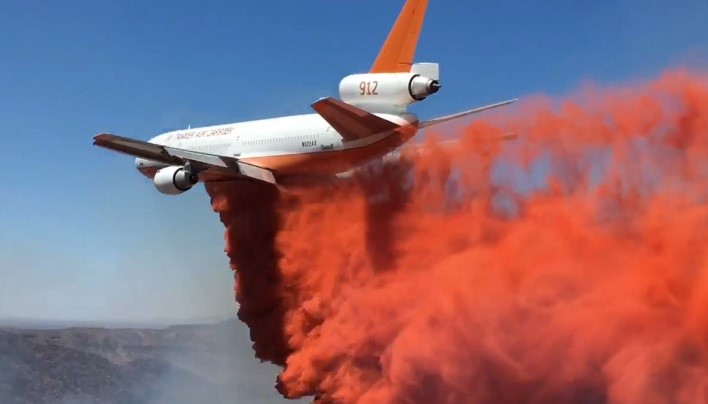FSEEE is featured on the front page of the July 3 issue of the Los Angeles Times in Hayley Smith’s article about fire retardant. Smith accurately points out some of the problems with Phos-Chek, the widely used red retardant that contains ammonium phosphate. “Studies have shown the retardant can harm plants, fish and other species, including steelhead trout and Chinook salmon,” Smith reports. “It can also act as a fertilizer that grows more vegetation, which can later act as fuel for fires.”
These problems, combined with the lack of scientific evidence showing Phos-Chek makes any difference in wildfire outcomes, provide some of the rationale behind FSEEE’s recent lawsuit against the Forest Service regarding its careless use of the chemical slurry, which often ends up polluting waterways.
Smith contacted FSEEE Executive Director Andy Stahl, who told her, “Fire retardant has more adverse effects on endangered species than any other thing the federal government does, and there’s not even a close second.”
Smith reports that Perimeter Solutions, the Missouri-based manufacturer of Phos-Chek, is marketing a new fire retardant that is intended to be sprayed along roadsides in advance of fire season. The new product, Phos-Chek Fortify, “has many of the same ingredients as the aerial spray” and is intended to remain on vegetation until the first major rainfall.
Hugh Safford, a researcher at UC Davis and former ecologist with the Forest Service, told Smith that the idea “to render the vegetation less flammable” long-term has merit. However, he expressed reservations about the unproven product, “given that we know that ammonium phosphate has effects, particularly in aquatic systems, and given that we don’t know much, if anything, about turning this into a roadside application.”
Perimeter President Jeff Emery told Smith, “The use of ground applications for retardant allows more precise delivery to ensure avoidance of waterways,” which was the focus of FSEEE’s lawsuit, in which the judge ruled that Forest Service use of aerial retardant is violating the Clean Water Act.
Former wildland firefighter Timothy Ingalsbee, Ph.D., agrees with Andy, arguing that “resources would be better spent hardening homes and communities and conducting controlled burns, which are ‘more effective and actually less damaging than chemical warfare.'”
As Smith reports, Ingalsbee is a long-time critic of aerial retardant use by fire authorities, and he “calls the use of both materials ‘a government boondoggle.'” He says Phos-Chek is overused and frequently deployed in areas where it is ineffective. He told Smith that the new product “will only help the manufacturer earn even more profits.”
Andy told Smith that Phos-Chek Fortify’s fertilizer qualities make it an especially bad choice for roadside applications. “‘Although you may retard an ignition or a fire spread for this season, what you’ve done is grown a lot more biomass to burn in the next year.'”
“Meanwhile,” Smith writes, “dozens of California government organizations, as well as private and commercial landowners have begun using Phos-Chek Fortify.”


